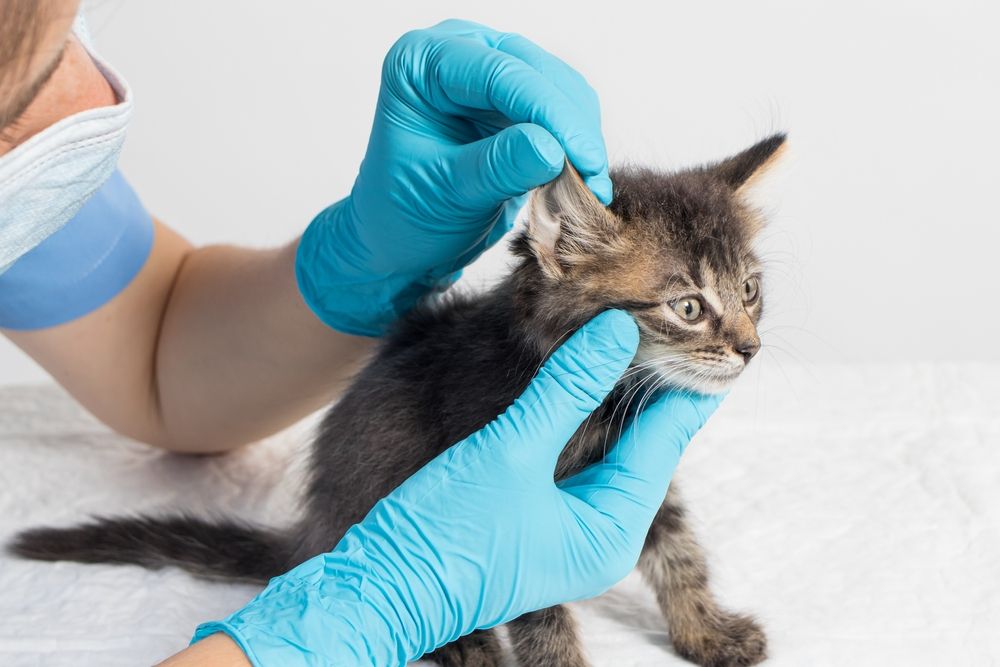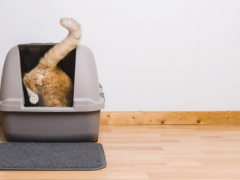
Shutterstock.com
Quick Overview: Hematomas on Cats' Ears





An ear hematoma, also called “aural hematoma,” is a blood-filled swelling that forms in your cat’s ear flap. They are usually caused by your cat shaking or scratching their ear excessively. This trauma causes small blood vessels inside the ear flap to burst, releasing a pocket of blood into the space between the skin and the cartilage. If the swelling is large, it can make your cat’s ear droop and they may hold their head to the side.
Most ear hematomas occur because of an underlying issue with the ear, such as an ear infection or ear mites, which has caused your cat to scratch and shake their head. Cats with ear hematomas need veterinary attention to treat the hematoma and to diagnose and treat the underlying cause. Whilst many cases can be managed with medication, some cats need surgery to resolve the hematoma.
Causes of Ear Hematoma
Ear hematomas aren’t as common in cats as they are in dogs. Most cats that develop ear hematomas have an underlying problem with the ear which has caused them to shake or scratch their ears excessively, and it is this action that causes the ear hematoma to form.
There are lots of reasons why cats get itchy ears. Some of the most common underlying problems that lead to ear hematomas include:
- Ear infections
- Ear mites
- Foreign objects (like a piece of grass)
- Allergies
Occasionally, ear hematomas can occur because of trauma to the head or ear, especially in cats with a bleeding or clotting disorder.
Symptoms of Ear Hematomas
Ear hematomas look like a large fluid-filled swelling on the inner surface of the ear. They are usually soft and hot to the touch, and the skin may be slightly red. The swelling can make your cat’s ear droop, and they may hold their head to one side. Most cats with ear hematomas show signs that they are uncomfortable.
Common symptoms of ear hematomas include:
- Swelling in the ear flap
- Shaking head
- Scratching ears
- Tenderness around the ear
- Distressed behavior
- Head tilt
- Discharge from the ear
- Foul smell
Diagnosis of Ear Hematomas
Ear hematomas are easy to diagnose based on just their appearance. However, your veterinarian will need to perform a thorough examination to try and find out why it happened in the first place. They will look inside your cat’s ear canal using an otoscope to identify parasites (such as ear mites), foreign material, or signs of infection.
If they suspect an ear infection, they may take a sample from your cat’s ear to look at under the microscope or send it for culture and sensitivity testing. If your cat has a history of problems with their ears or skin, your veterinarian may do additional tests, such as allergy testing.
In rare cases, ear hematomas can form without any apparent problem with the ear. In these cases, your veterinarian may want to check your cat’s blood is clotting normally.
Treatment of Ear Hematomas

Treatment of ear hematomas includes treating any underlying problem, such as ear infections. Shutterstock.com
While there is a lot you can do at home to help your cat recover, cats with an ear hematoma need treatment from a veterinarian.
Drainage
The first step is to drain the swelling. This is done using a special needle called a butterfly needle, which is attached to a drainage tube and a syringe. Once your veterinarian has removed the blood, they may inject an anti-inflammatory medication such as a steroid into the space. This helps to prevent the hematoma from re-forming by reducing associated inflammation. Ear hematomas can be very sore, so your vet will also prescribe pain relief for your cat to take home.
Often, hematomas need draining more than once. However, if your cat’s ear hematoma is not getting better after draining and medication, they may need surgery.
Surgery for Ear Hematomas
Surgery is recommended for ear hematomas that have not responded to draining and medication.
After placing your cat under general anesthesia, your veterinarian will make a small surgical incision in the skin of your cat’s ear. This allows them to drain the blood completely. Next, they will place sutures (stitches) to attach the skin of the pinna (your cat’s ear flap) to the layer of cartilage inside. This closes the space that has opened between them to prevent the swelling from reforming.
After surgery, your cat will be sent home with a bandage and an Elizabethan collar. While cats hate wearing cones, it is important to keep it on at all times to stop them from damaging the ear.
Treating the Underlying Cause
As well as fixing the hematoma, your veterinarian will treat any underlying cause that was found. This could involve antibiotic ear drops for an ear infection, topical medications for ear mites, or anti-itch medication for an allergy.
Eventually, ear hematomas will resolve, even if left untreated. However, this is painful, and the ear is left thickened and crinkled – like a wrestler with the classic ‘cauliflower ear’. This excessive scarring is not only unsightly, it can also make your cat more prone to ear problems in the future. So, it is best to get your cat’s ear hematoma treated quickly.
Cat Care Tips
Once your vet has drained your cat’s ear hematoma, the after-care will be up to you. There are lots of steps you can take at home to help your cat recover as quickly as possible:
- Keep the cone on: While your cat may not love wearing an Elizabethan collar, preventing further damage to the ear is vital for their recovery. So, make sure your cat wears it at all times until your veterinarian says it is safe to remove it.
- Give your cat all their medications: Giving your cat all their medications on time will help them stay comfortable and treat the underlying cause of the hematoma. If you’re struggling to give your cat their medication, ask your veterinary team for their help.
- Follow your vet’s instructions: Successful treatment of an ear hematoma in cats relies just as much on the home care you provide. Your vet surgeon will send you home with instructions on caring for your cat’s surgical site and keeping them comfortable. Be sure to follow their medical advice to give your cat the best chance of a full recovery.
- Attend follow-up visits: Ear hematomas can be tricky to resolve, so your veterinarian will need to keep a close eye on your cat’s recovery process. They may need to change your cat’s treatment plan depending on how they are doing.
With proper treatment and care, most cats with ear hematomas will recover within a week or two.
Prevention of Ear Hematomas

Ear care should form part of a regular grooming regime for cat owners. Shutterstock.com
Ear hematomas almost always form because of an additional condition that causes the ears to become irritated. Therefore, there are steps you can take at home to manage itchy ears before they get to the point of developing a hematoma:
- Keep cat’s ears clean: If your cat suffers from dirty ears, cleaning them regularly will help prevent them from becoming sore or infected. Not sure how? Here’s a handy guide for cleaning your cat’s ears.
- Early intervention: Most ear hematomas occur because of cats shaking their heads excessively due to irritated ears. Getting your cat’s sore ears treated as soon as you notice discomfort prevents them going on to develop a hematoma.
- Regular parasite treatment: Keeping your cat up to date with parasite treatment will protect them against ear mites. It also helps to reduce their risk of skin disease.
- Manage underlying allergies: Allergies are a common cause of recurrent ear issues in cats. If your cat has itchy skin or ears, then get them checked by your vet. Treating your cat’s allergies will prevent them from developing secondary problems like ear hematomas.
Frequently Asked Questions
How do you treat a hematoma on a cat's ear?
Ear hematomas (also called aural hematomas) in cats require treatment from a veterinarian. In most cases, they require draining, as well as medication to prevent them from reforming. Some cats will require aural hematoma surgery for a permanent solution. Any underlying problem, such as an infection, will also need treating.
How can I treat my cat's hematoma at home?
You should not treat your cat's hematoma at home. Ear hematomas are painful, and often occur because of an underlying issue with the ear which also needs diagnosing and treating. If your cat has an ear hematoma you should take them to your veterinarian for proper veterinary care.
Can I drain my cat's hematoma?
You should not try to drain your cat's ear hematoma at home. There is a risk of making the hematoma worse and causing infection. Your cat will also need medication to treat the underlying cause of the hematoma, which your vet will need to prescribe.
Will a hematoma in a cat's ear go away on its own?
Eventually, your cat's ear hematoma will go away on its own. However, this usually takes a very long time and will cause your cat a lot of discomfort. When ear hematomas are left untreated they leave the cat with a thickened, crinkly ear—like a cauliflower ear in a wrestler. This leaves them prone to developing other ear issues in the future.







